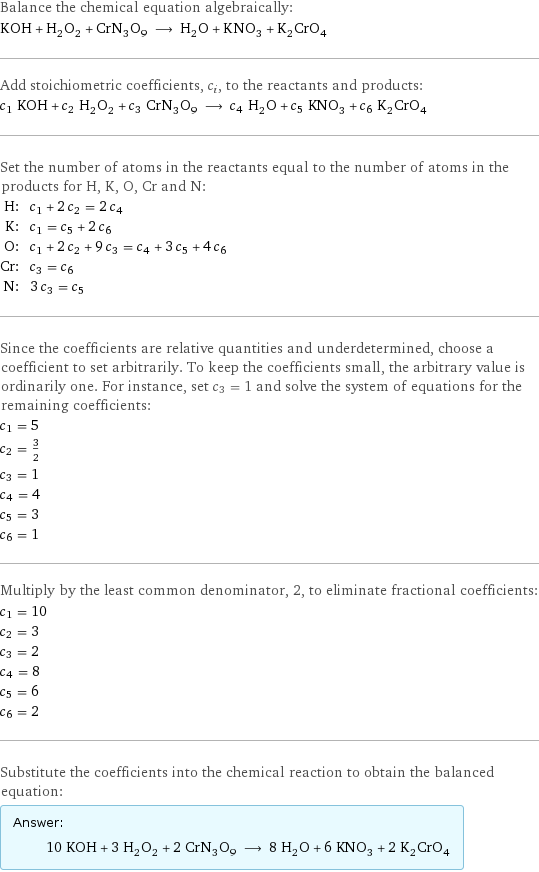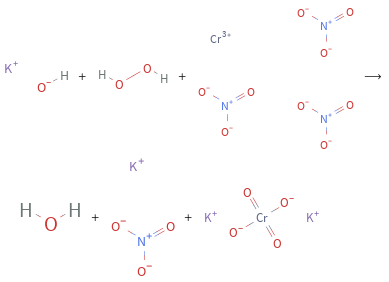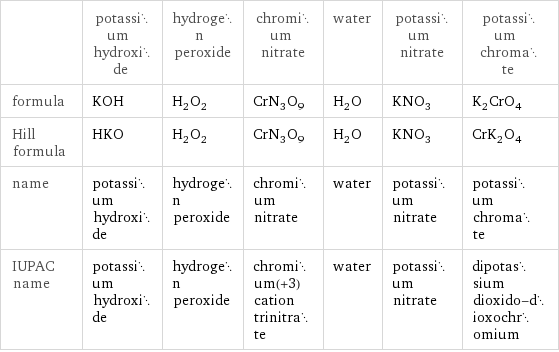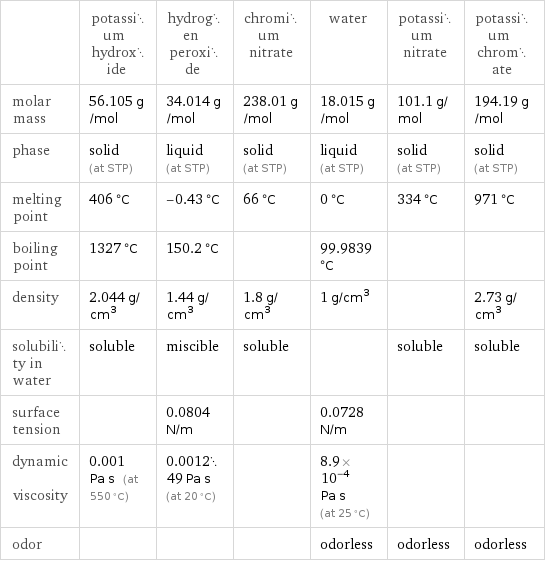Input interpretation

KOH potassium hydroxide + H_2O_2 hydrogen peroxide + CrN_3O_9 chromium nitrate ⟶ H_2O water + KNO_3 potassium nitrate + K_2CrO_4 potassium chromate
Balanced equation

Balance the chemical equation algebraically: KOH + H_2O_2 + CrN_3O_9 ⟶ H_2O + KNO_3 + K_2CrO_4 Add stoichiometric coefficients, c_i, to the reactants and products: c_1 KOH + c_2 H_2O_2 + c_3 CrN_3O_9 ⟶ c_4 H_2O + c_5 KNO_3 + c_6 K_2CrO_4 Set the number of atoms in the reactants equal to the number of atoms in the products for H, K, O, Cr and N: H: | c_1 + 2 c_2 = 2 c_4 K: | c_1 = c_5 + 2 c_6 O: | c_1 + 2 c_2 + 9 c_3 = c_4 + 3 c_5 + 4 c_6 Cr: | c_3 = c_6 N: | 3 c_3 = c_5 Since the coefficients are relative quantities and underdetermined, choose a coefficient to set arbitrarily. To keep the coefficients small, the arbitrary value is ordinarily one. For instance, set c_3 = 1 and solve the system of equations for the remaining coefficients: c_1 = 5 c_2 = 3/2 c_3 = 1 c_4 = 4 c_5 = 3 c_6 = 1 Multiply by the least common denominator, 2, to eliminate fractional coefficients: c_1 = 10 c_2 = 3 c_3 = 2 c_4 = 8 c_5 = 6 c_6 = 2 Substitute the coefficients into the chemical reaction to obtain the balanced equation: Answer: | | 10 KOH + 3 H_2O_2 + 2 CrN_3O_9 ⟶ 8 H_2O + 6 KNO_3 + 2 K_2CrO_4
Structures

+ + ⟶ + +
Names

potassium hydroxide + hydrogen peroxide + chromium nitrate ⟶ water + potassium nitrate + potassium chromate
Equilibrium constant
![Construct the equilibrium constant, K, expression for: KOH + H_2O_2 + CrN_3O_9 ⟶ H_2O + KNO_3 + K_2CrO_4 Plan: • Balance the chemical equation. • Determine the stoichiometric numbers. • Assemble the activity expression for each chemical species. • Use the activity expressions to build the equilibrium constant expression. Write the balanced chemical equation: 10 KOH + 3 H_2O_2 + 2 CrN_3O_9 ⟶ 8 H_2O + 6 KNO_3 + 2 K_2CrO_4 Assign stoichiometric numbers, ν_i, using the stoichiometric coefficients, c_i, from the balanced chemical equation in the following manner: ν_i = -c_i for reactants and ν_i = c_i for products: chemical species | c_i | ν_i KOH | 10 | -10 H_2O_2 | 3 | -3 CrN_3O_9 | 2 | -2 H_2O | 8 | 8 KNO_3 | 6 | 6 K_2CrO_4 | 2 | 2 Assemble the activity expressions accounting for the state of matter and ν_i: chemical species | c_i | ν_i | activity expression KOH | 10 | -10 | ([KOH])^(-10) H_2O_2 | 3 | -3 | ([H2O2])^(-3) CrN_3O_9 | 2 | -2 | ([CrN3O9])^(-2) H_2O | 8 | 8 | ([H2O])^8 KNO_3 | 6 | 6 | ([KNO3])^6 K_2CrO_4 | 2 | 2 | ([K2CrO4])^2 The equilibrium constant symbol in the concentration basis is: K_c Mulitply the activity expressions to arrive at the K_c expression: Answer: | | K_c = ([KOH])^(-10) ([H2O2])^(-3) ([CrN3O9])^(-2) ([H2O])^8 ([KNO3])^6 ([K2CrO4])^2 = (([H2O])^8 ([KNO3])^6 ([K2CrO4])^2)/(([KOH])^10 ([H2O2])^3 ([CrN3O9])^2)](../image_source/2588ac5108951523ed4eba7d3bf2073e.png)
Construct the equilibrium constant, K, expression for: KOH + H_2O_2 + CrN_3O_9 ⟶ H_2O + KNO_3 + K_2CrO_4 Plan: • Balance the chemical equation. • Determine the stoichiometric numbers. • Assemble the activity expression for each chemical species. • Use the activity expressions to build the equilibrium constant expression. Write the balanced chemical equation: 10 KOH + 3 H_2O_2 + 2 CrN_3O_9 ⟶ 8 H_2O + 6 KNO_3 + 2 K_2CrO_4 Assign stoichiometric numbers, ν_i, using the stoichiometric coefficients, c_i, from the balanced chemical equation in the following manner: ν_i = -c_i for reactants and ν_i = c_i for products: chemical species | c_i | ν_i KOH | 10 | -10 H_2O_2 | 3 | -3 CrN_3O_9 | 2 | -2 H_2O | 8 | 8 KNO_3 | 6 | 6 K_2CrO_4 | 2 | 2 Assemble the activity expressions accounting for the state of matter and ν_i: chemical species | c_i | ν_i | activity expression KOH | 10 | -10 | ([KOH])^(-10) H_2O_2 | 3 | -3 | ([H2O2])^(-3) CrN_3O_9 | 2 | -2 | ([CrN3O9])^(-2) H_2O | 8 | 8 | ([H2O])^8 KNO_3 | 6 | 6 | ([KNO3])^6 K_2CrO_4 | 2 | 2 | ([K2CrO4])^2 The equilibrium constant symbol in the concentration basis is: K_c Mulitply the activity expressions to arrive at the K_c expression: Answer: | | K_c = ([KOH])^(-10) ([H2O2])^(-3) ([CrN3O9])^(-2) ([H2O])^8 ([KNO3])^6 ([K2CrO4])^2 = (([H2O])^8 ([KNO3])^6 ([K2CrO4])^2)/(([KOH])^10 ([H2O2])^3 ([CrN3O9])^2)
Rate of reaction
![Construct the rate of reaction expression for: KOH + H_2O_2 + CrN_3O_9 ⟶ H_2O + KNO_3 + K_2CrO_4 Plan: • Balance the chemical equation. • Determine the stoichiometric numbers. • Assemble the rate term for each chemical species. • Write the rate of reaction expression. Write the balanced chemical equation: 10 KOH + 3 H_2O_2 + 2 CrN_3O_9 ⟶ 8 H_2O + 6 KNO_3 + 2 K_2CrO_4 Assign stoichiometric numbers, ν_i, using the stoichiometric coefficients, c_i, from the balanced chemical equation in the following manner: ν_i = -c_i for reactants and ν_i = c_i for products: chemical species | c_i | ν_i KOH | 10 | -10 H_2O_2 | 3 | -3 CrN_3O_9 | 2 | -2 H_2O | 8 | 8 KNO_3 | 6 | 6 K_2CrO_4 | 2 | 2 The rate term for each chemical species, B_i, is 1/ν_i(Δ[B_i])/(Δt) where [B_i] is the amount concentration and t is time: chemical species | c_i | ν_i | rate term KOH | 10 | -10 | -1/10 (Δ[KOH])/(Δt) H_2O_2 | 3 | -3 | -1/3 (Δ[H2O2])/(Δt) CrN_3O_9 | 2 | -2 | -1/2 (Δ[CrN3O9])/(Δt) H_2O | 8 | 8 | 1/8 (Δ[H2O])/(Δt) KNO_3 | 6 | 6 | 1/6 (Δ[KNO3])/(Δt) K_2CrO_4 | 2 | 2 | 1/2 (Δ[K2CrO4])/(Δt) (for infinitesimal rate of change, replace Δ with d) Set the rate terms equal to each other to arrive at the rate expression: Answer: | | rate = -1/10 (Δ[KOH])/(Δt) = -1/3 (Δ[H2O2])/(Δt) = -1/2 (Δ[CrN3O9])/(Δt) = 1/8 (Δ[H2O])/(Δt) = 1/6 (Δ[KNO3])/(Δt) = 1/2 (Δ[K2CrO4])/(Δt) (assuming constant volume and no accumulation of intermediates or side products)](../image_source/125204f5fa2573c2596ff795e82223c2.png)
Construct the rate of reaction expression for: KOH + H_2O_2 + CrN_3O_9 ⟶ H_2O + KNO_3 + K_2CrO_4 Plan: • Balance the chemical equation. • Determine the stoichiometric numbers. • Assemble the rate term for each chemical species. • Write the rate of reaction expression. Write the balanced chemical equation: 10 KOH + 3 H_2O_2 + 2 CrN_3O_9 ⟶ 8 H_2O + 6 KNO_3 + 2 K_2CrO_4 Assign stoichiometric numbers, ν_i, using the stoichiometric coefficients, c_i, from the balanced chemical equation in the following manner: ν_i = -c_i for reactants and ν_i = c_i for products: chemical species | c_i | ν_i KOH | 10 | -10 H_2O_2 | 3 | -3 CrN_3O_9 | 2 | -2 H_2O | 8 | 8 KNO_3 | 6 | 6 K_2CrO_4 | 2 | 2 The rate term for each chemical species, B_i, is 1/ν_i(Δ[B_i])/(Δt) where [B_i] is the amount concentration and t is time: chemical species | c_i | ν_i | rate term KOH | 10 | -10 | -1/10 (Δ[KOH])/(Δt) H_2O_2 | 3 | -3 | -1/3 (Δ[H2O2])/(Δt) CrN_3O_9 | 2 | -2 | -1/2 (Δ[CrN3O9])/(Δt) H_2O | 8 | 8 | 1/8 (Δ[H2O])/(Δt) KNO_3 | 6 | 6 | 1/6 (Δ[KNO3])/(Δt) K_2CrO_4 | 2 | 2 | 1/2 (Δ[K2CrO4])/(Δt) (for infinitesimal rate of change, replace Δ with d) Set the rate terms equal to each other to arrive at the rate expression: Answer: | | rate = -1/10 (Δ[KOH])/(Δt) = -1/3 (Δ[H2O2])/(Δt) = -1/2 (Δ[CrN3O9])/(Δt) = 1/8 (Δ[H2O])/(Δt) = 1/6 (Δ[KNO3])/(Δt) = 1/2 (Δ[K2CrO4])/(Δt) (assuming constant volume and no accumulation of intermediates or side products)
Chemical names and formulas

| potassium hydroxide | hydrogen peroxide | chromium nitrate | water | potassium nitrate | potassium chromate formula | KOH | H_2O_2 | CrN_3O_9 | H_2O | KNO_3 | K_2CrO_4 Hill formula | HKO | H_2O_2 | CrN_3O_9 | H_2O | KNO_3 | CrK_2O_4 name | potassium hydroxide | hydrogen peroxide | chromium nitrate | water | potassium nitrate | potassium chromate IUPAC name | potassium hydroxide | hydrogen peroxide | chromium(+3) cation trinitrate | water | potassium nitrate | dipotassium dioxido-dioxochromium
Substance properties

| potassium hydroxide | hydrogen peroxide | chromium nitrate | water | potassium nitrate | potassium chromate molar mass | 56.105 g/mol | 34.014 g/mol | 238.01 g/mol | 18.015 g/mol | 101.1 g/mol | 194.19 g/mol phase | solid (at STP) | liquid (at STP) | solid (at STP) | liquid (at STP) | solid (at STP) | solid (at STP) melting point | 406 °C | -0.43 °C | 66 °C | 0 °C | 334 °C | 971 °C boiling point | 1327 °C | 150.2 °C | | 99.9839 °C | | density | 2.044 g/cm^3 | 1.44 g/cm^3 | 1.8 g/cm^3 | 1 g/cm^3 | | 2.73 g/cm^3 solubility in water | soluble | miscible | soluble | | soluble | soluble surface tension | | 0.0804 N/m | | 0.0728 N/m | | dynamic viscosity | 0.001 Pa s (at 550 °C) | 0.001249 Pa s (at 20 °C) | | 8.9×10^-4 Pa s (at 25 °C) | | odor | | | | odorless | odorless | odorless
Units
